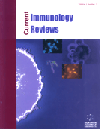- Home
- A-Z Publications
- Current Immunology Reviews (Discontinued)
- Previous Issues
- Volume 4, Issue 4, 2008
Current Immunology Reviews (Discontinued) - Volume 4, Issue 4, 2008
Volume 4, Issue 4, 2008
-
-
The Expanding Universe of γ δ T Lymphocytes: Subsets, Generation and Function
More LessAuthors: Serena Meraviglia, Nadia Caccamo, Carmela La Mendola, Giuliana Guggino and Francesco Dieliγδ T cells which express the Vγ9 and Vδ2 gene products are unique to primates and represent only a minor population of peripheral blood T lymphocytes. They recognize nonpeptidic phosphoantigens in an MHC-unrestricted fashion and show low dependence on costimulation. The ability of Vγ9Vδ2 T cells to develop immunological memory remains debated. Vγ9Vδ2 T cells are able to mount both immediate effector functi Read More
-
-
-
Negative Regulation of TCR Signaling in Immunological Tolerance: Taming Good and Evil
More LessAuthors: Martina Gatzka and Craig M. WalshTo prevent the occurrence and expansion of autoreactive T cell clones, and hence the development of autoimmune disease (such as multiple sclerosis, rheumatoid arthritis, lupus erythematosus, and diabetes), the healthy immune system is equipped with a variety of immunological mechanisms, summarized as self-tolerance. The strength and frequency of the T cell receptor (TCR) signal as well as the costimulatory c Read More
-
-
-
From the Obscure and Mysterious Acute Phase Response to Toll-Like Receptors and the Cytokine Network
More LessThe discovery of C-reactive protein (CRP) almost 80 years ago in the blood of patients with various infectious and inflammatory diseases initiated studies on the mysterious biological phenomenon called “the acute phase response” (APR). The complex metabolic alterations accompanying APR include changes in the plasma concentration of the majority of liver-produced proteins - acute phase proteins (APPs). The search for me Read More
-
-
-
Hepatocytes as Cytotoxic Effector Cells
More LessAuthors: Clifford S. Guy and Tomasz I. MichalakThe liver is increasingly recognized as an immune competent organ wherein aberrant T cell responses to dietary or autoantigens are suppressed, thereby contributing to the maintenance of peripheral immune tolerance. Furthermore, the liver is constitutively capable of trapping and retention of activated T cells, irrespective of their antigenic specificity, leading to the proposed hypothesis that it may represent a site of eliminati Read More
-
-
-
Role of TARC/CCL17 and CTACK/CCL27 in the Pathogenesis of Atopic Dermatitis
More LessAuthors: Hidehisa Saeki and Kunihiko TamakiTARC/CCL17 is designated as a Th2 type chemokine since it binds to CCR4. CTACK/CCL27 is a ligand for CCR10 and is selectively expressed in skin. Atopic dermatitis (AD) is a chronic inflammatory skin disease that is characterized by the predominant infiltration of Th2-type cells, especially in the acute phase. We have determined that serum levels of TARC and CTACK are elevated in AD patients and reflect the disease activity of A Read More
-
-
-
Role of Leptin in the Immune System
More LessAdipose tissue is no longer considered mere energy storage, but an important endocrine organ that produces many signals in a tightly regulated manner. Leptin is one of the most important hormones secreted by the adipocyte, with a variety of physiological roles related with the control of metabolism and energy homeostasis. One of these functions is the connection between nutritional status and immune competence. The Read More
-
-
-
Antigenic Peptide Vaccination: Provoking Immune Response and Clinical Benefit for Cancer
More LessRecent immunotherapy depends largely on understanding of the molecular interactions between T cell receptors (TCR) on cytotoxic T lymphocytes (CTL) and peptide/MHC class I complexes on tumor cells. Many tumor antigens identified by cDNA library expression cloning methods, especially from malignant melanoma, have greatly contributed to clarifying such mechanisms and led to peptide vaccination trials, mainly for pati Read More
-
-
-
Immunological Aspects of Adult T-Cell Leukemia/Lymphoma (ATLL), a Possible Neoplasm of Regulatory T-Cells
More LessAuthors: Yasuaki Yamada and Shimeru KamihiraAdult T-cell leukemia/lymphoma (ATLL) is a distinct disease caused by the first discovered human oncogenic retrovirus, human T-cell leukemia virus type-1 (HTLV-1). The peculiarity of this disease is not only in its causative agent HTLV-1 but also in the character of leukemia cells. ATLL cells express the mature helper/inducer T-cell antigens, CD2, CD3, CD4 and CD5 but usually lacking CD8. Despite CD4 expression, it has long been kno Read More
-
Volumes & issues
Most Read This Month
Article
content/journals/cir
Journal
10
5
false
en


